| Date: 1944 Mar 06/06 | A/C Type: B-17F Fortress | SN: 42-31025 | Code: GY-B | A/C Nickname: | 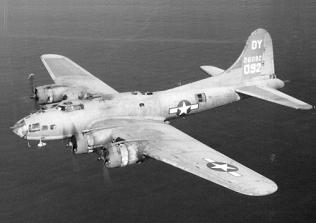 |
|||||
| File: 680 | Airforce: USAAF | Sqn/Unit: 381 BG - 533 BS | Mission/Raid: VKF Ball Bearing Works Erkner, Berlin. | |||||||
| 1 | Pilot | 2Lt. Albert A. Adams DFC + Oak Leaf Cluster | 9 | RWG | S/Sgt. Martin Cech. evd, with undergr. | |||||
| 2 | Co-pilot | 2Lt. Joseph B. Mathis III | 10 | TG | S/Sgt. John K. Hedberg WIA, POW, | |||||
| 3 | Nav. | 1Lt. William Barnes | 11 | |||||||
| 4 | B | 1Lt. Arnold J. Bugni | 12 | |||||||
| 5 | E | T/Sgt. Lloyd B. Keene KIA (shot in the air) | 13 | |||||||
| 6 | RO | T/Sgt. Matthew 'Max' E. Palenica evd, later POW. | 14 | |||||||
| 7 | BTG | S/Sgt. Laurence R. Stevenson | 15 | |||||||
| 8 | LWG | S/Sgt. Cleo C. White evd, later POW. | 16 | |||||||
On route back from target, lost first one, later two engines. Became straggler. A German fighter riddled the fuselage and the four rearest gunners bailed-out, wounded. T/Sgt. Keene dead in top turret. This was near Ommen/Dalfsen. With a lot of luck, the remaining five in the aircraft managed to fly back from Holland to England on 150 feet altitude. |
||||||||||
What happened to Lt. Adam's B-17 is very typical for what happened to many others on the 6 March 1944 Berlin raid. Damaged by Flak, lost formation and in the long stretch trying to get back to England they became prey for German fighters. Adam should have been one of the hundreds of Allied bombers that went down in Lake IJsselmeer during WW2, but because of luck and skill his story is different. Four crew bailed out north of Zwolle. Lt. Adam reached England flying on tree top level.
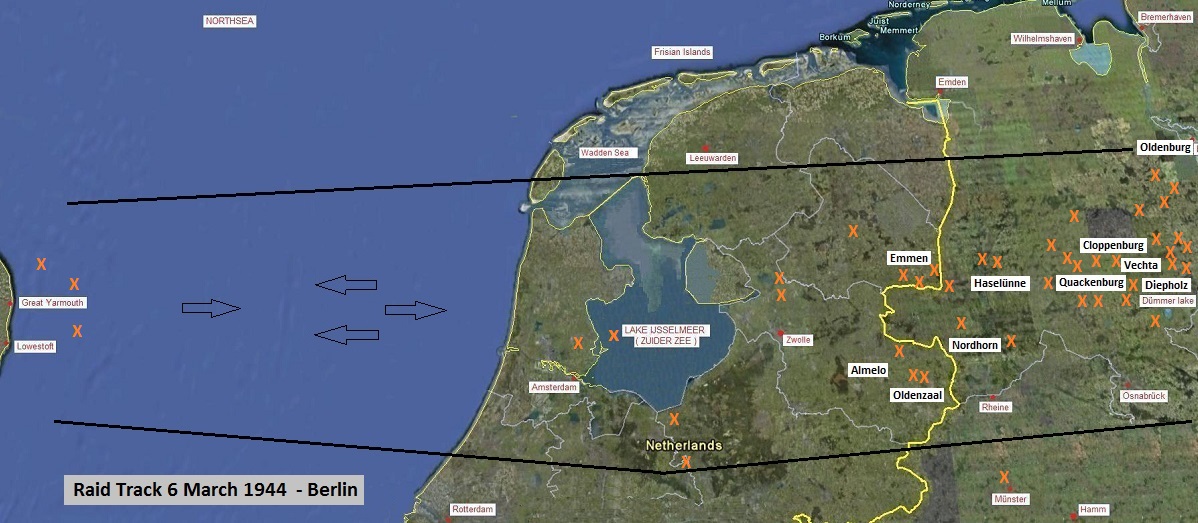
Pilot. "The flight to the target was uneventful. Over the target (Berlin) we encountered a moderate amount of Flak. As we turned off the target the right outboard engine failed. Both Lt. Mathis and I tried to feather the propeller without success. Looking out the window we both noticed that an oil slick started appearing on the top of the wing, indicating Flak damage. Maybe preventing feathering propeller. Although I increased power on the other engines we could not keep up with the squadron and gradually fell behind. When squadron was out of sight we were attacked by Me-109's. Evasion action was taken. Attacks from 16:00 and 10 o'clock high, causing extensive damage. Left outboard engine knocked out".
German pilot Lt. Lothar Sachs: "after a high speed dive on the bombers, I caught sight of a lone B-17 some way behind the formation and moved in for the attack. I had not much experience and opened fire at too great range, scored no hits (I thought). The bomber vanished into a thin bank of cloud. Out of the cloud I attacked again and fired a second long burst but again did not see any hits. Now the bomber was in the clear on the far side of the cloud bank, but I was out of ammunition. The bomber was firing red flares for help, but there were no Allied fighters around. The Americans had no way of knowing I was out of ammo. Perhaps I could bluff them into abandoning their machine? I pulled in behind the bomber for a dummy firing pass, then watched an escape hatch fall away".
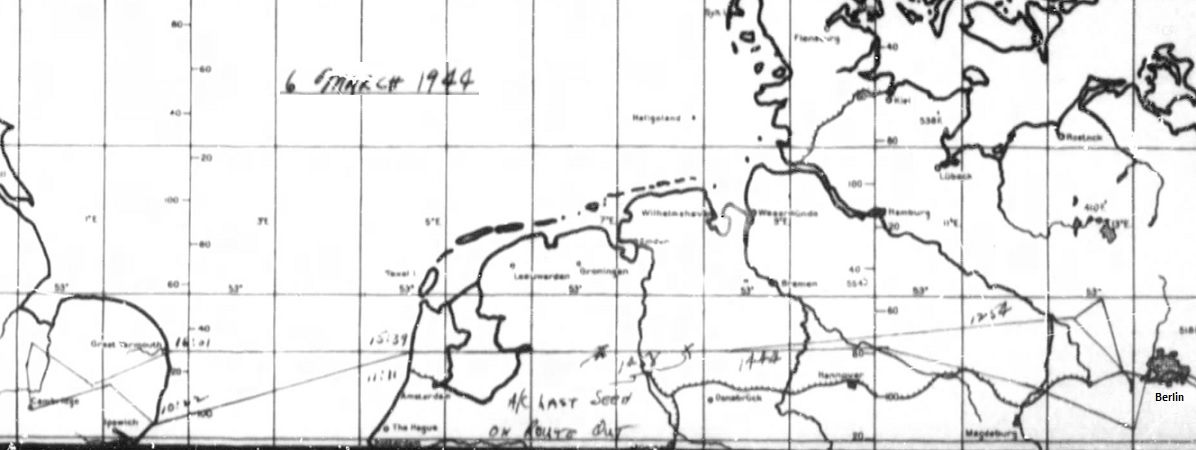
Radio operator Matthew 'Max' Palenica: "We started to lose altitude. Lt. Adams gave the bail out order twice, but Lt. Mathis (killed 22 October 1944) twice said no. At this a time (Me-109 attacked), a shell burst in the radio room where I was and I was wounded in the face, leg, hand and back. I staggered into the waist. The rear door was pushed out and one man was bailing out (White). The other waist gunner was getting ready to bail out. I looked at him and he was hurt across the head and had blood all over his face. He too jumped (this was Martin Cech, who had back full of shrapnel). Just before I was going to jump something hit me in the leg. I looked up there I saw tail gunner John Hedberg, stuck in the tail. I got him out and saw that he was badly hit in the hand. I immediately put a tourniquet around his wrist to stop the bleeding. Two fingers were gone and he was in a daze. I asked him if he could pull his rip cord and he nodded that he could. I put his legs out the the door and kicked him out. I feel that I probably saved his life. I followed him out the door".
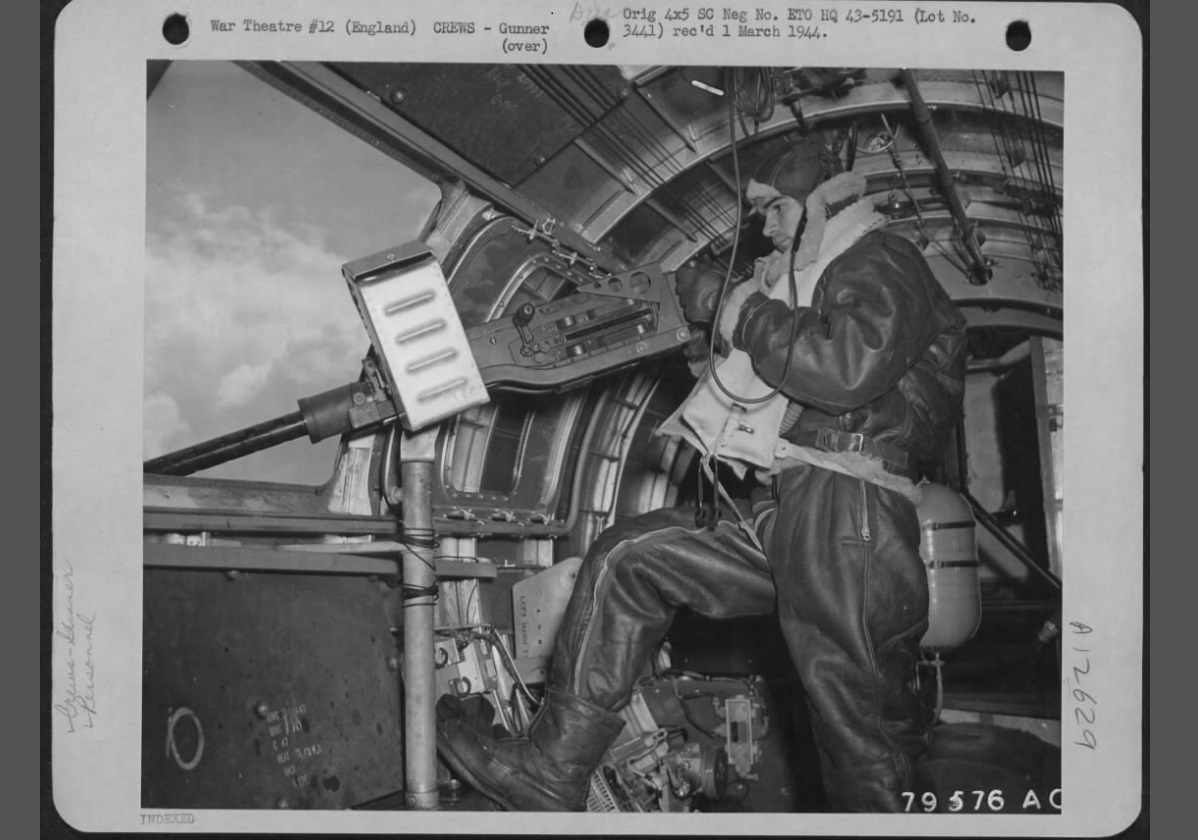
German Me-109 pilot Lothar Sachs: "Four crew were leaving by parachute. I was congratulating myself with my first victory and closed in to inspect my pray that continued to fly west. I flew past very close, about 10 meters over the top. As I passed the nose I dropped my left wing to take a closer look and found myself gazing into the faces of the pilots and the top gunner who were staring back at me! I pulled my wing up and tried to accelerate away, but as I did my Messerschmitt shuddered under the impact of bullet hits. Wondering what to do next I pulled to a respectful distance and watched the bomber descend gradually. Still hoped it might go down and crash so I could claim it. But 15 meter above the Zuider Sea he leveled out, still heading west and there was nothing I could do. Then my left radiator poured white smoke; the glycol system had been hit. I reduced speed and turned for one of our airfields in East-Holland".
Pilot. "The attacks disabled tail guns, the ball turret, the gyro compass, radio, intercom system, damaging fuel transfer lines and the flight controls. We we both pinned back in our seats. The force of the control column was so great that physically I could not move it forward. The plane lost forward speed, nosed up and stalled, falling off to the right in a steep dive. Regained level flight at 5000 ft. With windmilling props and to stay above 115 mph, it was necessary to boost the other two engines to almost take-off RPM. All happened in 3 to 4 minutes by which time the RO, waist gunners and TG had bailed out. Our flight was at 115 mph to England from 5000 ft to tree top level. Bombardier Lt. Arnold Bugni came up the cockpit and reported Sgt. Keene (Engineer) had been killed. Sgt. Stevenson from the BTG reported that four crew had bailed out and someone was wounded because there was blood splattered in the waist gun area."
"The windmilling prop shanks broke and with both propellers windmilling now freely the drag on the plane was somewhat reduced. Fuel got low. As we exited the cloud bank we spotted enemy aircraft and decided to head for the deck. Flying at tree top level, the enemy aircraft gave up the chase. We crossed the coast in the vicinity over the Zuider Zee (he crossed the Dutch North Sea coastline after he overpassed the Zuider Sea flying low). At the coast line the German anti-aircraft batteries were located. As we headed out over the North Sea, the shore batteries peppered our tail with Flak but did not do any more serious damage. A short time later, two RAF fighters appeared. The Cliffs of Dover were considerably higher than the altitude we were flying. By increasing power slightly and putting down about 10 degrees of flaps I started a gradual climb. We were about 150 to 200 ft above ground level when we crossed cliffs. Airfield was just ahead and we made a wheels down landing. We were debriefed. A short time later a 306th B-17 picked us up and we were flown to home base Thurleigh. It certainly was a long day for us".
Lt. Albert A. Adams received the Oak Leaf Cluster in addition to the DFC previously awarded.
The four men that bailed out.
Tail gunner S/Sgt. John K. Hedberg was seriously wounded, he had his thumb and index finger shot off. On the ground he was taken POW. The other three men could hide themselves in bushes and haystacks. Next day they were helped by civilians and came in contact with the underground. S/Sgt. Martin Cech worked actively with the underground in the Eastern Netherlands until liberation by the Canadians in April 1945. S/Sgt. Cleo C. White and T/Sgt. Max Palenica were brought together in the safehouse of the very brave Kingma family in Vollenhove (No. 4 and 5 on list below). From there they were moved north by pilot helper Ms. Tini Mulder. End 1944 both were arrested in the south of the Netherlands, trying to get to Brussels start of the famous Comete escape line to Spain.
For more photos and info on the crew, please view website of PATS: http://www.teunispats.nl/jack-edward-gibbs.htm
When on this large page allow 10 seconds to load, then press CRTL + F and search on 'Hedberg'.
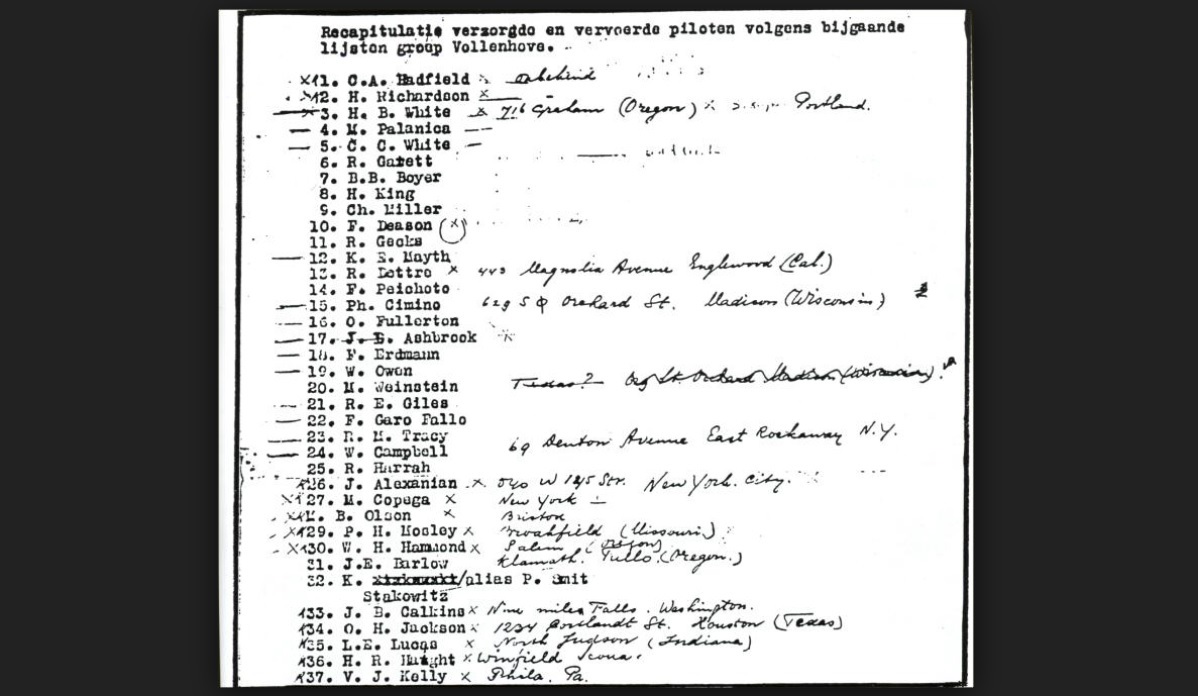
Story compiled from MACR, 306 Bomb Group site and publications and several published interviews with crewmembers.
© ZZairwar (Zuyder Zee Air War)
.